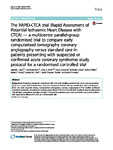The RAPID-CTCA trial (Rapid Assessment of Potential Ischaemic Heart Disease with CTCA) — a multicentre parallel-group randomised trial to compare early computerised tomography coronary angiography versus standard care in patients presenting with suspected or confirmed acute coronary syndrome: study protocol for a randomised controlled trial
| dc.contributor.author | Gray, AJ | |
| dc.contributor.author | Roobottom, C | |
| dc.contributor.author | Zhu, Chengyong | |
| dc.contributor.author | Goodacre, S | |
| dc.contributor.author | Oatey, K | |
| dc.contributor.author | O’Brien, R | |
| dc.contributor.author | Storey, RF | |
| dc.contributor.author | Na, L | |
| dc.contributor.author | Lewis, SC | |
| dc.contributor.author | Thokala, P | |
| dc.contributor.author | Newby, DE | |
| dc.date.accessioned | 2022-02-17T14:04:29Z | |
| dc.date.available | 2022-02-17T14:04:29Z | |
| dc.date.issued | 2016-12-07 | |
| dc.identifier.issn | 1745-6215 | |
| dc.identifier.issn | 1745-6215 | |
| dc.identifier.other | 579 | |
| dc.identifier.uri | http://hdl.handle.net/10026.1/18815 | |
| dc.description.abstract |
BACKGROUND: Emergency department attendances with chest pain requiring assessment for acute coronary syndrome (ACS) are a major global health issue. Standard assessment includes history, examination, electrocardiogram (ECG) and serial troponin testing. Computerised tomography coronary angiography (CTCA) enables additional anatomical assessment of patients for coronary artery disease (CAD) but has only been studied in very low-risk patients. This trial aims to investigate the effect of early CTCA upon interventions, event rates and health care costs in patients with suspected/confirmed ACS who are at intermediate risk. METHODS/DESIGN: Participants will be recruited in about 35 tertiary and district general hospitals in the UK. Patients ≥18 years old with symptoms with suspected/confirmed ACS with at least one of the following will be included: (1) ECG abnormalities, e.g. ST-segment depression >0.5 mm; (2) history of ischaemic heart disease; (3) troponin elevation above the 99th centile of the normal reference range or increase in high-sensitivity troponin meeting European Society of Cardiology criteria for 'rule-in' of myocardial infarction (MI). The early use of ≥64-slice CTCA as part of routine assessment will be compared to standard care. The primary endpoint will be 1-year all-cause death or recurrent type 1 or type 4b MI at 1 year, measured as the time to such event. A number of secondary clinical, process and safety endpoints will be collected and analysed. Cost effectiveness will be estimated in terms of the lifetime incremental cost per quality-adjusted life year gained. We plan to recruit 2424 (2500 with ~3% drop-out) evaluable patients (1212 per arm) to have 90% power to detect a 20% versus 15% difference in 1-year death or recurrent type 1 MI or type 4b MI, two-sided p < 0.05. Analysis will be on an intention-to-treat basis. The relationship between intervention and the primary outcome will be analysed using Cox proportional hazard regression adjusted for study site (used to stratify the randomisation), age, baseline Global Registry of Acute Coronary Events score, previous CAD and baseline troponin level. The results will be expressed as a hazard ratio with the corresponding 95% confidence intervals and p value. DISCUSSION: The Rapid Assessment of Potential Ischaemic Heart Disease with CTCA (RAPID-CTCA) trial will recruit 2500 participants across about 35 hospital sites. It will be the first study to investigate the role of CTCA in the early assessment of patients with suspected or confirmed ACS who are at intermediate risk and including patients who have raised troponin measurements during initial assessment. TRIAL REGISTRATION: ISRCTN19102565 . Registered on 3 October 2014. ClinicalTrials.gov: NCT02284191. | |
| dc.format.extent | 579- | |
| dc.format.medium | Electronic | |
| dc.language | en | |
| dc.language.iso | en | |
| dc.publisher | BMC | |
| dc.subject | Acute coronary syndrome | |
| dc.subject | Chest pain assessment | |
| dc.subject | CT coronary angiogram | |
| dc.subject | Cardiac CT | |
| dc.title | The RAPID-CTCA trial (Rapid Assessment of Potential Ischaemic Heart Disease with CTCA) — a multicentre parallel-group randomised trial to compare early computerised tomography coronary angiography versus standard care in patients presenting with suspected or confirmed acute coronary syndrome: study protocol for a randomised controlled trial | |
| dc.type | journal-article | |
| dc.type | Comparative Study | |
| dc.type | Journal Article | |
| dc.type | Multicenter Study | |
| dc.type | Randomized Controlled Trial | |
| dc.type | Research Support, Non-U.S. Gov't | |
| plymouth.author-url | https://www.webofscience.com/api/gateway?GWVersion=2&SrcApp=PARTNER_APP&SrcAuth=LinksAMR&KeyUT=WOS:000390388700002&DestLinkType=FullRecord&DestApp=ALL_WOS&UsrCustomerID=11bb513d99f797142bcfeffcc58ea008 | |
| plymouth.issue | 1 | |
| plymouth.volume | 17 | |
| plymouth.publication-status | Published | |
| plymouth.journal | Trials | |
| dc.identifier.doi | 10.1186/s13063-016-1717-2 | |
| plymouth.organisational-group | /Plymouth | |
| plymouth.organisational-group | /Plymouth/Faculty of Health | |
| plymouth.organisational-group | /Plymouth/Faculty of Health/Peninsula Medical School | |
| plymouth.organisational-group | /Plymouth/REF 2021 Researchers by UoA | |
| plymouth.organisational-group | /Plymouth/REF 2021 Researchers by UoA/UoA01 Clinical Medicine | |
| plymouth.organisational-group | /Plymouth/REF 2021 Researchers by UoA/UoA01 Clinical Medicine/UoA01 Clinical Medicine | |
| plymouth.organisational-group | /Plymouth/Users by role | |
| plymouth.organisational-group | /Plymouth/Users by role/Academics | |
| dc.publisher.place | England | |
| dcterms.dateAccepted | 2016-11-19 | |
| dc.rights.embargodate | 2022-2-18 | |
| dc.identifier.eissn | 1745-6215 | |
| dc.rights.embargoperiod | Not known | |
| rioxxterms.versionofrecord | 10.1186/s13063-016-1717-2 | |
| rioxxterms.licenseref.uri | http://www.rioxx.net/licenses/all-rights-reserved | |
| rioxxterms.licenseref.startdate | 2016-12-07 | |
| rioxxterms.type | Journal Article/Review |


